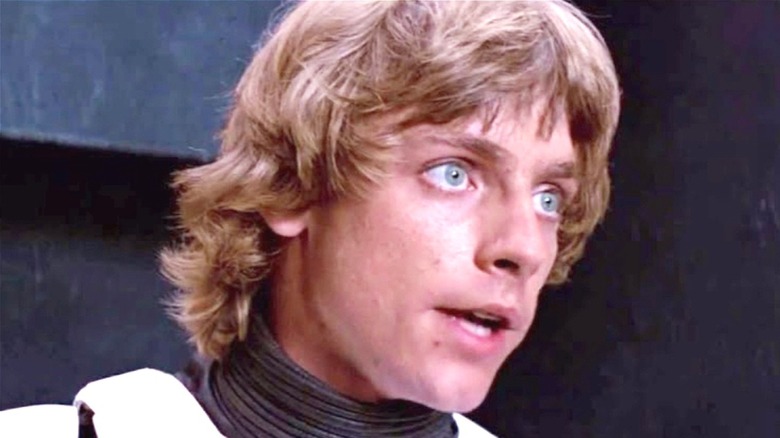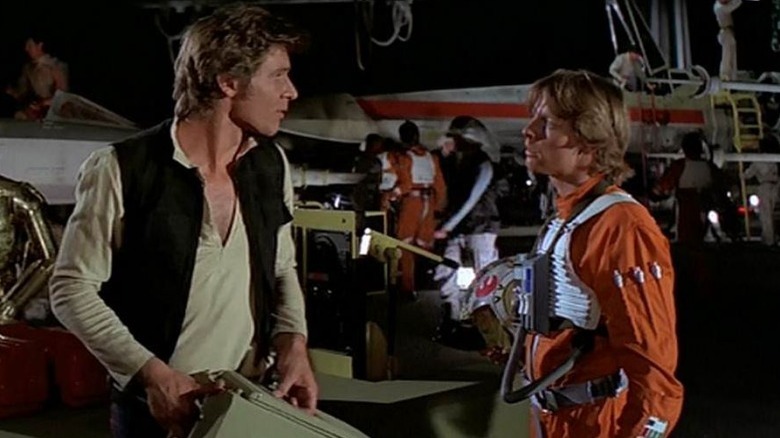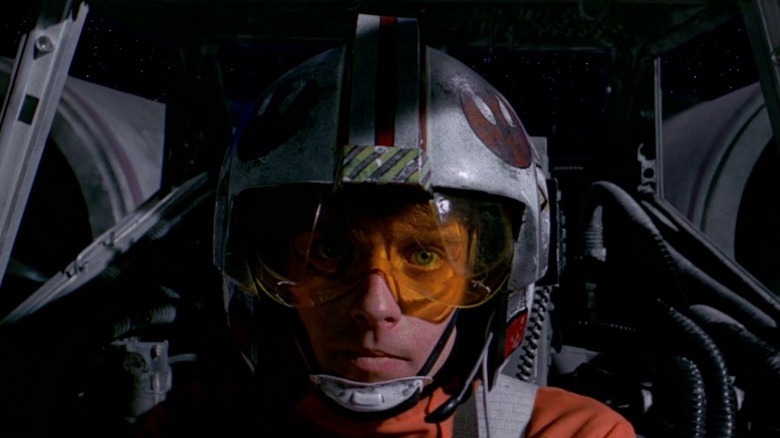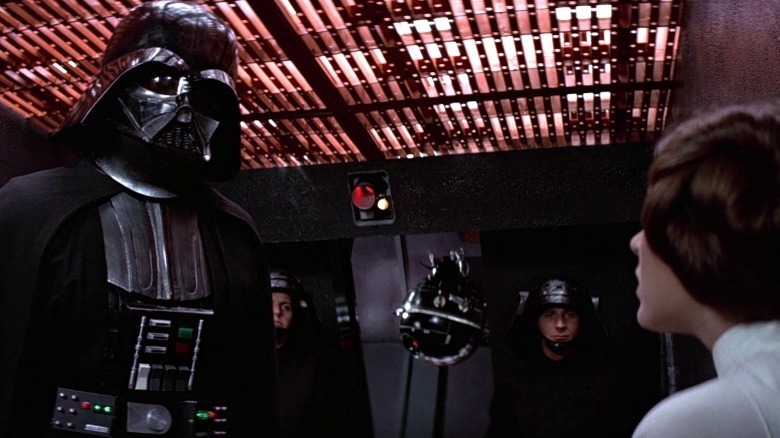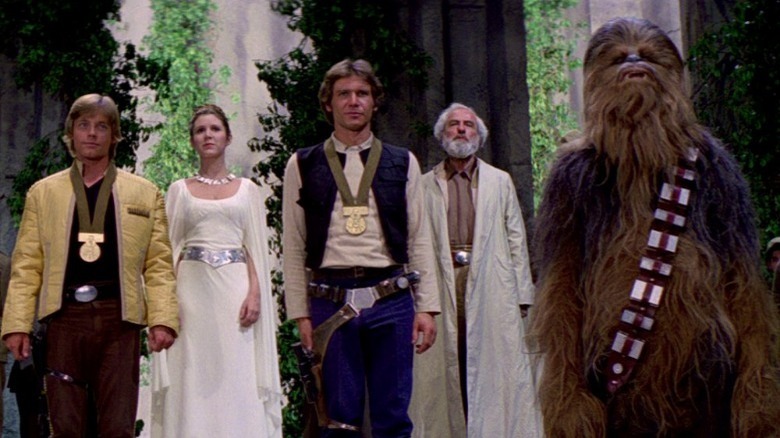The Ending Of Star Wars: A New Hope Explained
When George Lucas made "Star Wars: A New Hope," there was no guarantee that it would be the first (or fourth, depending on how you look at it) in a saga of films that made boffo box office and inspired theme parks. In fact, George Lucas didn't make "Star Wars: A New Hope," he made "Star Wars." The "A New Hope" subtitle was added on once "Star Wars" became something much bigger than any single movie. Few believed in the project, to the point that Fox let Lucas keep licensing and merchandising rights for the property in exchange for waiving a $500,000 directing fee — a shortsighted choice that The Hollywood Reporter estimates wound up costing Fox billions.
Lucas always had plans to expand the "Star Wars" universe. He wound up funding "The Empire Strikes Back" and "Return of the Jedi" with the merchandising money Fox passed up. But in making "A New Hope," Lucas had to drop enough story breadcrumbs to make sequels without rendering the first entry in the franchise unsatisfying. How can one make a story that works as a standalone film that also seeds movies yet to come? That's the lesson in the ending of "Star Wars: A New Hope."
The trench run and Han's return
The first "Star Wars" movie comes to a head in the iconic trench run sequence. According to the military history website We Are the Mighty, Lucas based the sequence heavily on a scene from the 1954 movie "The Dam Busters." That movie was based on the exploits of the RAF bomber "Lancaster."
Luke Skywalker (Mark Hamill) has joined Red Squadron in its attempt to blow up the Death Star. Han Solo (Harrison Ford) appears to have absconded with his reward money, probably going to pay off Jabba the Hutt. Leia (Carrie Fisher) is on the Rebel base on Yavin 4, overseeing the operation. Meanwhile, the Death Star is readying its planet-obliterating super-laser to yeet Yavin 4 out of the galaxy.
Luke is nearing the exhaust shoot — the Death Star's one weak point — when Darth Vader almost shoots him down. But at the last second, Han Solo emerges in the Millennium Falcon to knock Darth Vader off course. Han and Chewbacca save Luke, Luke saves Yavin 4. Cue award ceremony.
Han's choice to join the Rebel Alliance in full will have grave consequences in the next two films. Because he decided to go be a Big Damn Hero, Han misses his payment to Jabba. This causes Boba Fett to come after him in "Empire," and the gang spends the first chunk of "Return of the Jedi" freeing Han from Jabba's clutches.
Trusting the Force
When making the final shot to blow up the Death Star, Luke hears Obi-Wan Kenobi's (Alec Guinness) voice telling him to "use the Force" instead of his targeting computer. That turns out to be good advice, as Luke successfully blows up the Death Star with one shot. This moment helps solidify the mythology of the "Star Wars" universe. The first movie introduces the concept of the Force — a life-giving energy that binds all things — but it doesn't explore it as fully as later movies. But we're not talking about midi-chlorians now.
In "Empire," Luke continues his Jedi training under the tutelage of Master Yoda. He is instructed to do this by, you guessed it, the Force Ghost of Obi-Wan. We learn in the final prequel that Qui-Gon Jinn learned how to become a Force Spirit and passed that technique onto Yoda and Obi-Wan. We may even get to see some of this training in the upcoming Obi-Wan Kenobi series for Disney+. Thus, the ending of "A New Hope" touches "Star Wars" properties yet to come.
Darth Vader lives on
One big way "Star Wars: A New Hope" left room for its sequels was by not killing Darth Vader. Vader is the IP's strongest character: he is a direct link between the Empire and his children — Luke and Leia. His backstory is the basis of the prequel trilogy and "Clone Wars" television series, and his legacy pervades the sequel trilogy in the character of his grandson.
During the Battle of Yavin, Vader is knocked off course by Han and goes spinning off into the blackness of space. Ironically, this saves his life. Had he been near the Death Star when it blew up, we never would have gotten the "No, I am your father" scene of "The Empire Strikes Back," or his redemption arc in "Return of the Jedi."
Something "Star Wars" fans continue to debate is whether or not Vader could sense that Luke and Leia were his children in "A New Hope." Torturing your daughter for information, blowing up her adoptive planet, trying to blow up your son — these are not the actions of a loving father. It was probably easy for Vader to see Luke with Obi-Wan and put the pieces together. But he and Leia were together for a while before he figured it out. The "Star Wars" comic books and novels explain that Leia's strong will kept her father out of her mind, as explained by CBR.
Where's Chewie's medal?
"Star Wars: A New Hope" concludes with Princess Leia bestowing medals on the heroes of the Battle of Yavin. Luke, Han, and Chewie approach a dais, where Leia gives medals to Luke and Han — but not Chewie. What gives? Fans decried this seemingly speciesist snub for decades, until Chewie finally got his own medal in "Rise of Skywalker."
In 2019, George Lucas explained the missing medal controversy. "Chewbacca wasn't given a medal because medals don't really mean much to Wookiees," he said. "They don't really put too much credence in them. They have different kinds of ceremonies." Peter Mayhew, the actor behind Chewie's fur, had a more prosaic explanation when talking to CinemaBlend. "One, they didn't have enough money to buy me a medal," he explained. "Or two, Carrie couldn't reach my neck, and it was probably too expensive to build a little step so that I could step down or she could step up and give me the medal."
